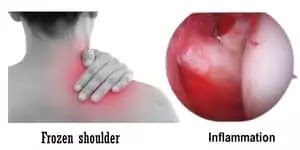The simplest and most convenient functional exercise method for frozen shoulder: (Expert Homeopathy: Dr. Anutosh Chakraborty)
Patients should do extra shoulder joint exercises: Especially large appropriate exercises, 10 minutes each time, which is very beneficial in preventing shoulder joint stiffness, stiffness, and contraction of soft shoulder muscles. Patients with small frozen shoulders can be treated with moderate exercise...
Bend over and draw circles: The patient with shoulders bends down, swings the affected arm, and takes the shoulder as the center to make a circular movement from the inside to the outside or from the outside to the inside, and use the swing of the arm to drive the shoulder joint movement.
Retract and squat: The patient stands with his back to the table, his hands are supported on the edge of the table, and squats are repeated to strengthen the extension of the shoulder joint.
The wall-climbing: The patient stands facing the wall, raises both hands, supports on the wall, and works hard to climb up, trying to climb higher than the previous day.
Exercise in the above 4 ways every morning and evening for at least three months. Those who do not cure can hold for a long time. You can exercise this way for a long time, suitable for the treatment and prevention of frozen shoulder.
Cause:
The main cause of frozen shoulder is Diabetes Mellitus, trauma is an additional cause. Sometimes shoulder surgery can lead to a frozen shoulder. Frozen shoulder can happen if you rest on a specific side for a long time, and every time on the same side.
Shoulder joint exercise:
Bend the elbow and shake the hand-the patient stands on the back against the wall, or lies on the bed, with the upper arm close to the body, bending the elbow, and using the elbow point as the fulcrum to perform external rotation activities.
Climbing the wall with fingers standing facing the wall, the patient uses the fingers of the affected side to slowly climb up the wall, raising the upper limbs as high as possible, making a mark on the wall, and then slowly returning to the original place. Repeatedly, gradually increase the height.
Pull the hands behind the body-the patient stands naturally, in the posture of the affected side's upper limbs internally rotated and extended backward, the healthy side pulls the affected side's hand or wrist, and gradually pulls to the healthy side and pulls upwards.
Stand with arms extended-the patient's upper limbs are naturally drooping, the arms are straightened, the palms of the hands are slowly abducted downwards, and the palms are slowly raised downwards. After reaching the maximum limit, stop for 10 minutes, then return to the original place and repeat.
Extend and touch the spines-the patient stands naturally, in the posture of internal rotation and backward extension of the upper limb on the affected side, bend the elbows, flex the wrists, and touch the spinous processes of the spine with the middle finger and gradually move upward to the maximum, and then stay stunned. Do not move, and then slowly return to the original place after 2 minutes, repeat it, and gradually increase the height.
Combing the hair-the patient can stand or lie on his back. The affected elbow is flexed, the forearm is forward and pronation (palm up), try to wipe the forehead with the elbow, that is, wipe the sweat.
Headrest with both hands lying on the patient's back, with both hands and ten fingers crossed, palms up, placed on the back of the head (occiput), first draw the elbows in as far as possible and then extend them as far as possible.
Shoulder rotation-the patient is standing, the affected limb is naturally drooping, the elbow is straightened, and the affected arm is circled from front to back, from small to large, repeated several times.
Please note that the above eight kinds of movements do not need to be done every time, you can choose to exercise alternately according to your specific situation, 3-5 times a day, generally do about 30 times for each movement, there is no limit to more, as long as you persevere, right Prevention and treatment of frozen shoulder will be of great benefit.
Symptoms:
Restricted movement of the side of the upper extremity where the frozen shoulder occurs.
The pain of the side, sometimes intercurrent.
The hardness of the affected side.
Mild worm over the affected side on touch.
Self-massage to prevent and treat frozen shoulder:
A special pressure point can be found between four toes and five toes. This point is a special area for treating shoulder infections. The left shoulder is painful, and the right foot is under pressure, while the right shoulder is sore and the left foot is pressed for ten minutes. In patients with shoulder grafting, ask family members to co-operate with the shoulder joints, that is, family members will come together with one hand to adjust the shoulder joint, and the other hand to hold the patient's wrist in a circle. Light heavy-duty, 20 minutes each time, twice a day.


Post a Comment